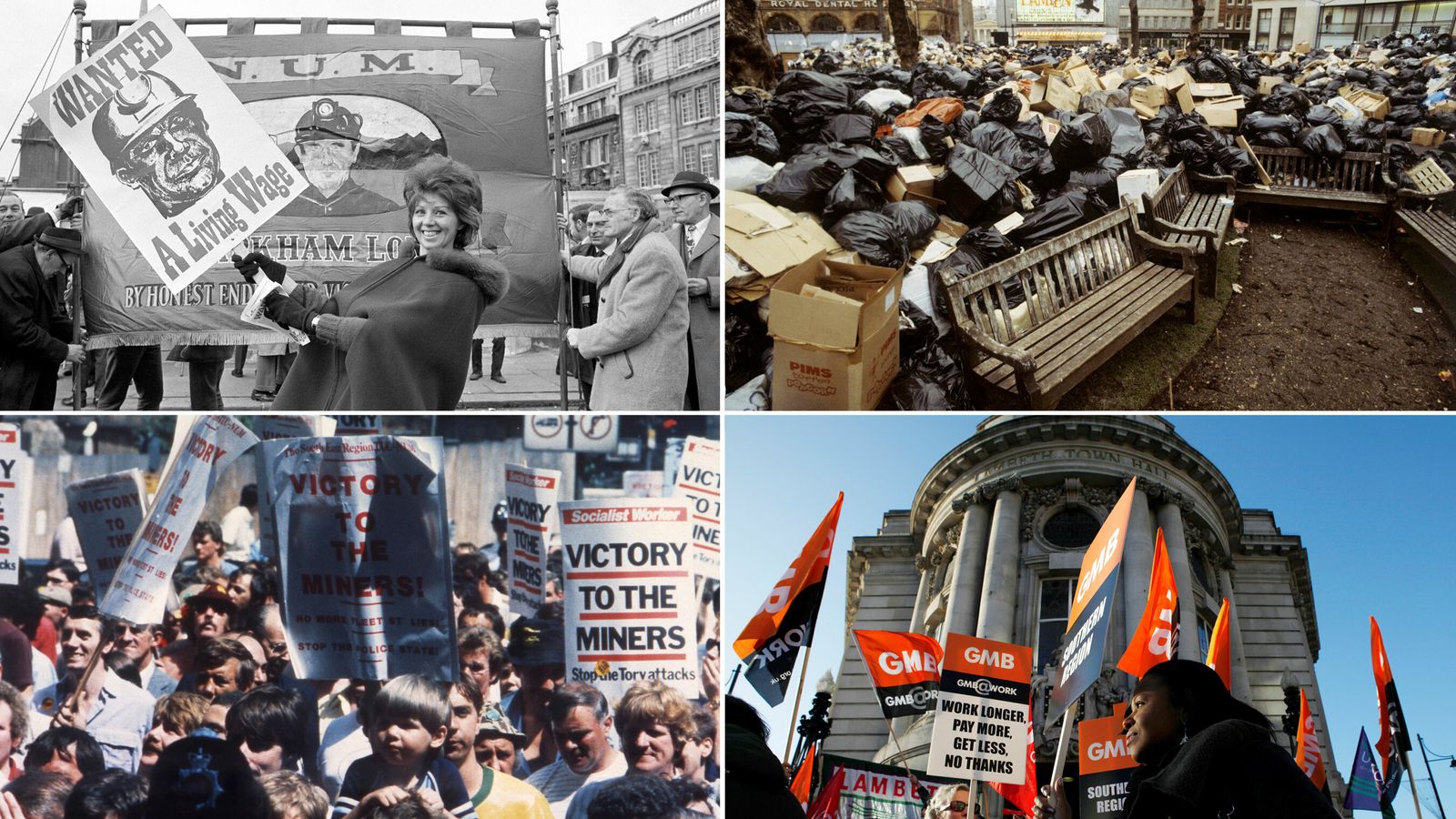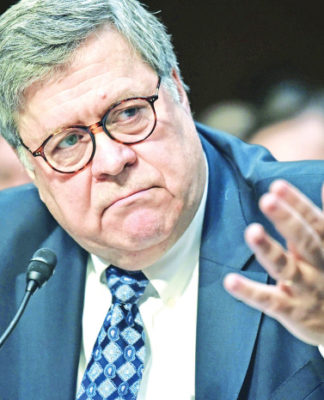Explainer
When have industries previously gone on strike and what has it achieved?
The UK is facing widespread strikes that have drawn comparisons with the 1979 winter of discontent – but what has previous industrial action achieved?
Faye Brown
Political reporter @fayebrownSky
Thursday 5 January 2023 16:28, UK
Pic:PA/Reuters/AP
Image:
Pic:PA/Reuters/AP
Why you can trust Sky News
The UK is facing the biggest outbreak of industrial action in a generation as thousands of workers across the NHS, transport, civil service and other sectors strike for better pay and conditions in the face of soaring inflation.
Union-led strike action has declined in recent decades – but this is not the first time mass walkouts have brought the country to a standstill.
Sponsored link
Recommended byWhat is Outbrain
From the onset of the industrial revolution, workers have been withholding their labour to bargain for more money and job security, achieving landmark gains such as eight-hour working days and equal pay for women.
But not all strikes are successful, with many resulting in a crackdown on union activity and no concessions for workers.
Often, the outcome has depended on the strength of the government at the time and public support behind the movement.
Here, Sky News looks at some of the biggest strikes in the last 100 years or so, and how they ended.
General strike of 1926
MORE ON STRIKES
Exams
Exams hit in Scottish schools as teachers go on strike over pay
Ambulance workers go on strike today – with NHS offering advice on how patients will be affected
Members of the RCN pictured on the picket line outside St Thomas' Hospital, central London, on 20 December
TUC announces ‘national right to strike day’ as unions vow to fight ‘draconian’ laws
Related Topics:
Strikes
The current wave of discontent has been likened to a de-facto “general strike” as union leaders talk up the possibility of co-ordinated action in 2023.
The last – and only time – the UK faced a general strike was in 1926.
For nine days, more than 1.5 million workers went on strike to support coal miners, whose bosses wanted to reduce pay and conditions.
The strike ended when the Trades Union Congress (TUC) called off the action without any concessions for the miners, after a court ruling that the action was illegal.
The miners were forced to accept the new terms and returned to work, while new laws were introduced to make general strikes and “sympathetic strikes” illegal.
Ford sewing machinists strike of 1968
In 1968, women sewing machinists at the Ford Motor Company plant in Dagenham, Essex, went on strike after their jobs were downgraded to unskilled, meaning they were being paid 85% of the rate paid to men.
Barbara Castle, Secretary of State for Employment and Productivity, intervened on behalf of the women and they returned to work three weeks later after their pay was raised to 92% of that of men.
A show of hands by 187 female sewing machinists at the Ford Plant in Dagenham, Essex, when they voted unanimously to return to work, ending their dispute.
Image:
The Ford sewing machinists strike was the catalyst for the Equal Pay Act of 1970
The dispute was a trigger for the Equal Pay Act 1970, which made it illegal to pay women less for doing the same job as men – though not for doing work of equal value.
It was only in 1984, following a nine-week long strike and widespread solidarity action from their male co-workers, that the Ford Dagenham women won their original demand for the same pay.
Miners’ strikes of the 1970s
During the 1970s, miners went on strike again for the first time since the failure of the general strike – this time with more success.
After talks over pay between the National Union of Mineworkers (NUM) and PM Edward Heath’s Conservative government broke down, the NUM called for industrial action at the start of 1972.
The action shut down coalmines, leading to power cuts and forcing the government to declare a state of emergency and three-day week to conserve electricity.
Despite the disruption, there was a great deal of public sympathy for the strikes, which came at a time of high inflation and unemployment.
Miners achieved an annual pay rise of 27% – well over the government’s wage restraint policy target of 7% to 8%.
Snug in a cape, Mrs Margaret Dobb of Kirkby, Nottingham, brnadishes a placard in vicinity of the Tower of London, here today. Margaret is the wife of a miner from Bentinck Colliery, Nottinghamshire, the largest colliery in Europe. She is among miners, their wives and trades unionists who plan to march from Tower Green to Westminster this afternoon where they will lobby MP's at the House of Commons.
Image:
The wife of a miner joins strike action for better pay in 1972
Inflation soon wiped out the gains and miners went on strike again in 1974. It led to another three-day week and marked the downfall of Mr Heath, who called a snap election in response to continued failed negotiations with the NUM.
This resulted in a hung parliament and a minority Labour government, led by Harold Wilson, who immediately increased the miners’ wages by 35%.
Read More:
More than a million work days lost to strike action in 2022
Striking similarities to ‘winter of discontent’ in 1970s
Winter of discontent
In 1978-1979, widespread strikes across multiple trade unions brought Britain to a standstill in what became known as the ‘winter of discontent’.
Unions demanded larger pay rises in response to attempts by James Callaghan, the Labour prime minister, to cap pay rises at 5% to bring down inflation.
The strikes resulted in empty shelves in supermarkets, a fuel shortage during the coldest winter in 16 years, rubbish on the streets and bodies not being buried.
JANUARY 31ST : On this day in 1979 industrial chaos continued due to workers striking over pay. MOUNTAIN'S OF RUBBISH DUMPED IN LEICESTER SQAURE, LONDON. THE RUBBISH HAS BEEN UNCOLLECTED BECAUSE OF A STRIKE BY CITY OF WESTMINSTER DUSTMAN IN SUPPORT OF A PAY CLAIM * 28/02/02 Pay talks involving 1.2 million council workers broke down today, bringing the threat of the first national strike since the Winter of Discontent 23 years ago. Union leaders rejected a 3% pay offer and warned of a ballot for industrial action among local authority employees in England, Wales and Northern Ireland. Workers will be urged not to accept the offer and to agree to a strike ballot, likely to be held in late April.
Image:
A mountain of rubbish in Leicester Square in London during a strike by city of Westminster bin collectors in 1979
Mr Alan Fisher (white mac), general secretart of NUPE, and Mr David Basnett (centre, tallest), general secretary of the General and Municipal Workers' Union, at the head of a mass march to Parliament where public services workers planned to lobby MPs as part of a “Day of Action” against Government pay policy.
Image:
A mass march to parliament where public services workers planned to lobby MPs for better pay during the ‘winter of discontent’
Many of the strikes led to substantial pay rises – but the unrest fuelled a public backlash against trade unions and spelled disaster for Mr Callaghan’s government and the wider Labour movement.
In May 1979, the Conservatives returned to power with a landslide victory under Margaret Thatcher, who introduced major restrictions on trade union power.
Miners’ strike of 1984-85
Miners went on strike again in 1984 – but this one played out differently to the success of the 1970s.
The year-long dispute was dominated by violent clashes and ended in defeat for the miners, changing the face of Britain’s industrial landscape forever.
It was over plans to close 20 pits deemed uneconomic – leading to the loss of around 20,000 jobs.
Banner Carrying crowds demonstrate in a 'Day of Action' protest in support of striking coal miners in London, England in June 1984. (AP Photo/Peter Kemp)
Image:
Banner carrying crowds demonstrate in a ‘day of action’ protest in support of striking coal miners in London in June 1984. Pic: AP
Police grapple with a floored picket at the Orgreave Coking Plant, near Rotherham, as lorry loads of coke leave for the British Steel Corporation's Scunthorpe plant, 40 miles away.
Arrests came as the pickets, who had been kept well away from the entrance by scores of policeman, suddenly started to rush the police lines.
Image:
Police grapple with a picketer at the Orgreave Coking Plant during the miners’ strike of 1984
Controversially, the strike was called by the NUM without a ballot, causing divisions among miners and costing it vital support from the Labour party and TUC leadership.
At its peak, 142,000 workers went on strike and violence broke out at picket lines – the most notorious clash coming at the Orgreave Coking Plant near Rotherham in June 1984.
But unlike the strikes of the 1970s, Mrs Thatcher’s government was prepared for the long fight and had gathered significant stockpiles of coal, meaning the disruption was minimal.
The strike began to crumble as more and more miners, running out of money and suffering huge financial hardship, returned to work.
In March 1985, the strike ended without a deal and the pits were closed.
Read More: After 200 years, one of England’s last coal mines is closing
Public sector strikes 2011
The most recent large-scale industrial action happened in 2011, during the coalition government between David Cameron’s Conservatives and the Liberal Democrats.
Around two million public sector workers went on strike on 30 November in response to pension reforms, with the unrest resulting in 60% of schools closing and thousands of cancelled hospital operations.
Unions objected to government plans to make their members pay more and work longer to earn their pensions, but ministers said the cost of public service pensions had risen by a third in a decade, so the changes were needed.
Striking local government workers stand on a picket line outside Lambeth Town Hall in south London November 30, 2011. Teachers, nurses and border guards walked out on Wednesday as up to two million state workers staged Britain's first mass strike for more than 30 years in a growing confrontation with a deficit-cutting coalition government. REUTERS/Andrew Winning (BRITAIN – Tags: BUSINESS POLITICS SOCIETY EMPLOYMENT)
Image:
Striking local government workers stand on a picket line outside Lambeth Town Hall in south London on 30 November 2011
Pickets stand outside St Thomas' Hospital in central London November 30, 2011. Teachers, hospital staff and border guards will be among workers taking part in Britain's first mass strike for more than 30 years on Wednesday, adding to pressure on a coalition facing a weakening economy. REUTERS/Toby Melville (BRITAIN – Tags: BUSINESS POLITICS SOCIETY EMPLOYMENT)
Image:
Pickets stand outside St Thomas’ Hospital in central London on 30 November 2011
Polls suggested the majority of the public disapproved of the action, even though they opposed the changes Mr Cameron was proposing.
The strikes ended in a propaganda war over turnout and did not lead to any significant changes to the government’s plans.
After their victory at the 2015 election, the Conservatives clamped down on unions with new laws imposing a series of conditions before they could go on strike.
Criminal barristers’ strike
While a wave of industrial action is expected to continue this year, some sectors have voted to end their strikes after accepting pay offers.
In October, criminal defence barristers in England and Wales returned to courtrooms after the government offered a 15% fee rise – an extra £7,000 per year.
Read More:
Rolls-Royce Motor Cars gives factory workers pay award of up to 17.6% to avert strikes
British Airways workers call off summer strike action after pay offer accepted
BT workers also secured a £1,500 pay rise, with the union behind the action saying the offer would not have been made without the strikes over the summer.
Felixstowe port workers won a 15.5% pay increase over two years following strike action and last week more than 200 bin workers in Wirral ended their industrial action after securing a 15% pay rise backdated to April.






























